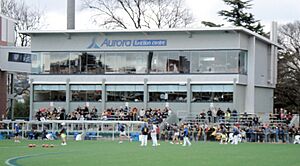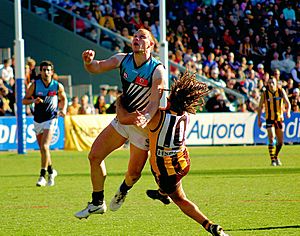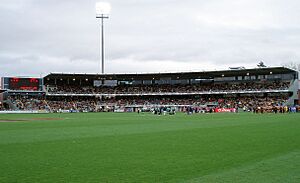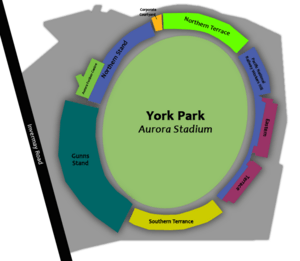York Park facts for kids
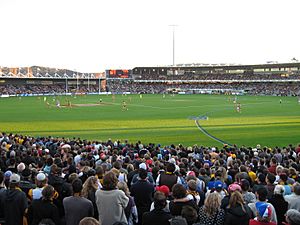 |
|
| Former names | Aurora Stadium (2004-2016) |
|---|---|
| Location | Launceston, Tasmania |
| Coordinates | 41°25′33″S 147°08′20″E / 41.42583°S 147.13889°E |
| Owner | Launceston City Council |
| Operator | AFL Tasmania |
| Capacity | 15,500 (13,106 seated) |
| Field size | 170 m × 140 m (560 ft × 460 ft) |
| Surface | Grass |
| Construction | |
| Broke ground | 1919 |
| Opened | 1921 |
| Construction cost | A$23.6M (redevelopment) |
| Tenants | |
|
Tasmania Football Club (AFL/AFLW) (2028–onwards)
Hobart Hurricanes (BBL) (2017-present) Western United FC (2021–2023) Perth Glory FC (2022) (2003 Rugby World Cup) |
|
| Ground information | |
| As of 30 December 2018 Source: Cricinfo |
|
York Park is a popular sports stadium in Launceston, Australia. It is officially known as the University of Tasmania (UTAS) Stadium. Before that, it was called Aurora Stadium for many years. This stadium can hold up to 21,000 people.
York Park is mostly used for Australian rules football games. Many exciting matches have been played here. The biggest crowd ever at the stadium was 20,971 people. This happened in June 2006 when the Hawthorn Football Club played against the Richmond Football Club in an Australian Football League (AFL) game.
The area where the stadium now stands was once a swamp. It was turned into a showground in 1873. Over time, it became a place for many sports like cricket, bowls, and tennis. In 1919, plans were made to turn it into a big multi-sports venue. Since 1923, it has been a main home for Australian rules football.
The Hawthorn Football Club has played several AFL matches here every year since 2001. The Tasmanian Government has helped fund these games. York Park has also hosted big concerts and international sports events. In 2005, the stadium had a major upgrade that cost $23.6 million. The Tasmanian Football Hall of Fame also opened here in 2009.
Contents
History of York Park
From Swamp to Sports Ground
The land that is now York Park was originally a swampy area full of weeds. After European settlers arrived, it was used to dump rubbish. In 1874, it became the Launceston showgrounds. By 1881, the Launceston City Council took over the land. They wanted to use it for recreation and enjoyment. By 1886, it was ready for cricket games.
Cricketers loved the new ground. However, it often became waterlogged in winter. This meant Australian rules footballers could not always use it.
Naming the Park and Early Sports
In July 1901, the council decided to rename Inveresk Park to York Park. This was to honor the Duke of York, who later became King George V. He visited Tasmania during the celebrations for the Federation of Australia in 1901.
By 1910, a bowling green and tennis courts were finished. The main oval was also used for school sports. In 1919, the council held a competition to design the new York Park sports ground. The winning design needed to include tennis courts, a bowling green, a cycling track, and grounds for cricket and football. It also needed dressing rooms and places for spectators.
York Park officially opened on January 1, 1921, even though it was not fully complete. A cycling track around the edge was ready by September of that year.
Football Takes Over
By May 1923, the main grandstand was finished. Football games moved from the NTCA Ground to York Park. The first game between teams from northern and southern Tasmania happened in August 1923. A crowd of 9,441 people watched.
A newspaper reporter noted that the oval was in good condition. A new motor mower could cut the entire five acres in six hours. Before games, people would walk across the field to pick up glass and other rubbish. This made sure players would not get hurt.
Challenges and Growth
Heavy floods in 1929 badly damaged the ground. The cycling track was destroyed but later rebuilt. In the 1930s, the Launceston Football Club played regularly at York Park. They won six championships in a row before World War II started.
Football matches were stopped during the war. They started again in May 1945. Three years later, 12 trees were planted at the ground. These trees honored NTFA players who died in the war.
In 1960, Tasmania's football team beat Victoria for the first time at York Park. About 15,000 people watched this historic match. In 1964, the southern stand was completed. Another stand was added in the 1970s, holding 650 spectators. It also had food kiosks and meeting rooms.
Modern Upgrades for AFL Games
Before 1999, York Park was mainly used for local events. Crowds were usually small. However, before the 1998 Australian federal election, money was promised to upgrade York Park. This $6.4 million upgrade, finished in 2000, was the first step to making the ground ready for Australian Football League (AFL) games.
The upgrades included building the Gunns Stand. This two-level stand could hold 2,500 people and now holds 5,700. It also has special areas for businesses. Other improvements included tall light towers for television broadcasts. A new watering system could handle heavy rain.
In 2003, the Government of Tasmania spent $2 million to add a roof over 6,000 seats. This was done for the 2003 Rugby Union World Cup. It meant most of the seating was protected from the weather. In 2004, the stadium became known as Aurora Stadium. This was because of a sponsorship deal with Aurora Energy.
In 2006, the state government provided $150,000 for new gates and ticket boxes. These gates were later named after former Tasmanian Premier Jim Bacon. These gates and the old Northern Stand are now listed as important heritage sites in Tasmania. The Cameron-Tyson stand was replaced in 2005 by an extension of the Gunns Stand.
Fire and Further Development
In March 2008, a fire damaged part of the Northern Stand. This caused between $300,000 and $500,000 worth of damage. In December 2008, the Launceston City Council suggested a $7 million plan to replace the stand. The old heritage roof of the Northern Stand was moved to Invermay Park.
The old structure at York Park was replaced with a new grandstand that seats 2,125 people. This new stand includes three AFL-standard changing rooms for players. It also has a changing room for AFL umpires. There are corporate facilities for 936 people, coaches' boxes, and rooms for media. These changes increased the stadium's capacity to 21,000 people. The seating capacity grew to 13,825.
Stadium Redevelopment for the Future
The Tasmanian Government has been working to get a Tasmanian team in the Australian Football League (AFL). As part of this, upgrading York Park became a big goal. In March 2022, the Premier of Tasmania announced plans to increase the stadium's seating capacity to 27,500.
This development was planned to happen within five years. It depended on two things: the federal government matching the state's $65 million contribution, and the stadium's ownership moving from the Launceston City Council to a state government agency called Stadiums Tasmania. The federal funding was secured in April 2023. Soon after, the Tasmania Football Club was approved to join the AFL for the 2028 season.
In November 2024, the Launceston City Council voted to transfer ownership of the stadium to Stadiums Tasmania. This cleared the way for construction to begin. The upgrades will improve facilities for match days, bringing umpire and changing rooms up to Australian tier 2 sporting standards. Major construction at the stadium is set to begin in July 2025. The redevelopment will include a new stand on the western side with function, corporate, and media facilities. There will also be new seating in the lower western stand and an updated eastern stand. These improvements are planned to be finished by 2027.
Sports and Events at York Park
Australian Rules Football
Australian rules football is the main sport played at York Park. The stadium has hosted Australian Football League (AFL) games since 2001. The state government started paying interstate clubs to play some of their home games here. The Melbourne-based Hawthorn played one game in 2001 and two in 2002. In 2003, another Melbourne team, St Kilda, also started playing games here.
In 2004, it was estimated that each game cost the government between $300,000 and $500,000. However, the Premier of Tasmania, Jim Bacon, said the government made a profit. He estimated that each game brought between $1 million and $1.5 million into Tasmania's economy.
The number of AFL matches reached its highest in 2006. Hawthorn played three home games and one pre-season game. St Kilda played two home games. These games attracted an average crowd of 17,108 people. The record attendance of 20,971 was for a match between Hawthorn and Richmond.
A funny controversy happened at York Park during a game between St Kilda and Fremantle. The final siren was too quiet for the umpires to hear. Play continued by mistake, and St Kilda scored to tie the game. After a protest, the AFL Commission changed the result, giving Fremantle the win. The stadium's sirens were replaced, and the old ones are now in a museum.
In 2007, York Park received a big sponsorship deal. The state government gave $16.4 million over five years to Hawthorn. Under this deal, Hawthorn plays five matches at the stadium each year. This includes one pre-season game and four regular season games.
Besides AFL games, York Park is the home ground for the North Launceston Football Club. It hosts regular Tasmanian State League matches. The ground also hosted some home games for the Tasmanian Devils Football Club in the Victorian Football League from 2001 to 2008.
In 2021, York Park hosted its first two AFL finals matches. This happened because of COVID-19 restrictions in Melbourne and Sydney. Both were elimination finals.
Hawthorn Football Club's Home Away From Home
The Hawthorn Football Club has played at York Park longer than any other AFL club. They have played up to four home games here each season since 2001. They have had exclusive use of the ground since the mid-2000s. In 2025, the club extended its agreement with the stadium until the end of the 2027 season. As of the end of the 2024 season, Hawthorn has won 61 out of 82 premiership matches at York Park. This is one of the best win records in the league.
Tasmania Football Club's Future Home
Hawthorn's agreement to play at York Park is expected to end in 2027. From 2028, the stadium will be one of the home grounds for the new Tasmania Football Club. This team, nicknamed the Devils, is set to start playing in the AFL in the 2028 season. The club will share its home games between York Park and the planned Macquarie Point Stadium in Hobart.
Other Sports and Entertainment
York Park hosted its first international sports event in 2003. This was a 2003 Rugby Union World Cup match between Romania and Namibia. Over 15,457 people watched the game.
The stadium has also hosted soccer matches. This includes one National Soccer League game and three A-League pre-season games. In July 2006, the stadium hosted Tasmania's first A-League match. The Melbourne Victory played against Adelaide United. This match has become a regular event. York Park has also hosted regular season A-League matches.
The stadium has also been a venue for non-sporting events. Before its upgrades, it hosted a concert by Ike & Tina Turner. It also held a religious meeting led by Billy Graham. The Crusty Demons performed at the stadium in 2006 and 2008. Elton John performed at York Park in 2007. This was his only concert in Tasmania.
Stadium Features and Facilities
York Park has an oval-shaped grass field. It is surrounded by several stands. The largest is the two-tier Gunns Stand on the western side. This stand was expanded in 2005 and can now hold 5,700 people. It also has two corporate box areas.
Next to the Gunns Stand is the Aurora Function Centre. This building also has coaches' boxes. It is near the heritage listed Northern Stand. This stand connects the Northern, Southern, and Eastern Terraces. These stands together can seat 6,000 people. This brings the stadium's total seating to 11,700.
The Railway Workers Hill is a small, uncovered stand on the eastern side. The stadium has parking for about 2,500 cars. This includes large grassy areas nearby and street parking.
York Park has sometimes been criticized for its large playing field. Some people say it leads to low-scoring football games. In 2009, the field was made 13 meters narrower to encourage more exciting games. The stadium is also known for its strong winds. These winds can make it hard to kick long distances accurately.
In 2005, a grant helped build a permanent Tasmanian Football Hall of Fame at York Park. The stadium was chosen because it is seen as the home of Australian rules football in Tasmania. The Hall of Fame opened to the public on February 21, 2009. By May 2009, $23.6 million had been spent on upgrading the stadium.
Stadium Naming Rights
On October 22, 2016, the University of Tasmania bought the naming rights for the stadium. This was a five-year contract that started on January 1, 2017. The university campus is located next to York Park. This deal ended a 13-year partnership with Aurora Energy, which had named the stadium Aurora Stadium.
Crowd Attendance Records
| Season | Average |
|---|---|
| 2022 | 12,060 |
| 2021 | 9,213 |
| 2019 | 13,922 |
| 2018 | 12,578 |
| 2017 | 13,197 |
| 2016 | 13,855 |
| 2015 | 13,851 |
| 2014 | 13,825 |
| 2013 | 13,238 |
| 2012 | 15,688 |
| 2011 | 15,716 |
| 2010 | 16,173 |
| 2009 | 17,420 |
| 2008 | 17,528 |
| 2007 | 17,403 |
| 2006 | 17,108 |
| 2005 | 15,772 |
| 2004 | 16,615 |
| 2003 | 16,707 |
| 2002 | 16,589 |
| 2001 | 17,460 |
| Total | 16,849 |
The highest number of people ever at York Park was 20,971. This was for an AFL match between Hawthorn and Richmond on June 18, 2006. This happened before the Northern Stand was damaged and the stadium's capacity was reduced. An AFL match between Hawthorn and St Kilda on August 8, 2009, had 20,011 people. This was the largest crowd since the fire. The lowest AFL attendance was 9,007 for a game between Hawthorn and Gold Coast on June 23, 2018.
The most people at an interstate football match at York Park was 15,000. This was for the 1960 game between Tasmania and Victoria.
For a Tasmanian Football League match, the highest attendance was 6,755. This was for the 1989 Second Semi Final between North Launceston and North Hobart on September 2, 1989.
The highest attendance for a soccer match was 8,061. This was when Melbourne Victory played Adelaide United on July 16, 2007. The Billy Graham religious meeting on March 17, 1959, attracted 17,000 people. This is a record for a non-sporting event at the ground.

The highest attendance for a Rugby Union match was 15,457. This was when Romania played Namibia on October 30, 2003, during the 2003 Rugby World Cup.
Top Sports Attendance Records
| No. | Date | Teams | Sport | Competition | Crowd |
|---|---|---|---|---|---|
| 1 | 18 June 2006 | Hawthorn vs. Richmond | Australian rules football | AFL | 20,971 |
| 2 | 8 August 2009 | Hawthorn vs. St Kilda | Australian rules football | AFL | 20,011 |
| 3 | 9 August 2008 | Hawthorn vs. Brisbane Lions | Australian rules football | AFL | 19,929 |
| 4 | 31 May 2008 | Hawthorn vs. Western Bulldogs | Australian rules football | AFL | 19,378 |
| 5 | 4 July 2004 | St Kilda vs. Port Adelaide | Australian rules football | AFL | 19,223 |
| 6 | 29 April 2012 | Hawthorn vs. Sydney | Australian rules football | AFL | 19,217 |
| 7 | 29 July 2007 | Hawthorn vs. Kangaroos | Australian rules football | AFL | 19,114 |
| 8 | 26 August 2006 | Hawthorn vs. Kangaroos | Australian rules football | AFL | 18,836 |
| 9 | 26 May 2007 | Hawthorn vs. West Coast | Australian rules football | AFL | 18,112 |
| 10 | 30 July 2016 | Hawthorn vs. Carlton | Australian rules football | AFL | 18,112 |
| 11 | 30 October 2003 | Romania vs. Namibia | Rugby Union | 2003 Rugby World Cup | 15,457 |
Last updated on 19 June 2025


